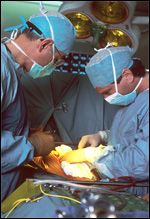MBCC: Systemic Therapy Before Surgery for All Breast Cancer Patients?
Typically women who are likely to be treated with systemic therapy before surgery have bulky disease. But should all breast cancer patients receive systemic neoadjuvant therapy?
Which breast cancer patients should receive systemic neoadjuvant therapy? Or should all breast cancer patients receive neoadjuvant therapy before surgery?

Should all breast cancer patients receive neoadjuvant therapy before surgery?
The issue of whether preoperative systemic treatment should become the norm was debated at the 29th Annual Miami Breast Cancer Conference by Ian Smith, head of the breast unit at the Royal Marsden Hospital and Institute of Cancer Research; and Eleftherios Mamounas, medical director of the Aultman Hospital Cancer Center in Canton, Ohio.
Typically, women who are likely to be treated with systemic therapy before surgery have bulky disease-the presurgery treatment can help shrink the tumor to make it easier to surgically remove.
Another reason to opt for neoadjuvant treatment is to prolong survival. "So far, however, there has not been very great evidence that you can actually prolong survival," explained Smith, who made a case for the pro side of the argument. The reason for the lack of evidence of prolonged survival with endocrine therapy is a lack of trials.
Smith pointed out the only study that has tested endocrine therapy prior to surgery. In that study, the National Surgical Adjuvant Breast and Bowel Project (NSABP) trial B-18, 976 women were given single-injection progesterone prior to surgical treatment. "There was a survival benefit for node-positive breast cancer patients, simply from one shot of progesterone," said Smith.
In the context of neoadjuvant chemotherapy, Smith highlighted that while the B-18 trial initially did not show any outcome difference between patients who did or did not receive chemotherapy before surgery, the long-term follow up did suggest the preoperative chemotherapy did make a difference for women under 50. The long-term data showed that in patients under 50 years of age, "there was actually a strong trend toward a survival benefit that began to emerge after 5 or 6 years," Smith said.
The NSABP B-18 trial compared preoperative chemotherapy with doxorubicin and cyclophosphamide (AC) vs the same chemotherapy treatment given after surgery. The women over 50 in the trial also received tamoxifen for 5 years.
On the con side of the argument, Eleftherios Mamounas, stressed that there were no differences in outcomes between neoadjuvant or adjuvant treatment in 3 trials: the NSABP B-18, EORTC 10902, and European Cooperative Trial in Operable Breast Cancer (ECTO) trials. He was skeptical of the B-18 trial in particular because the primary end point was not reached and only subsequent analysis found the age discrepancy in outcome. "More research is needed before this is applied in the clinic," he said.
Adjuvant therapy may be better for patients not likely to respond to neoadjuvant treatment, such as those with estrogen- and progesterone-receptor–positive, low Ki67 patients (luminal A subtype), said Mamounas.
"There is less enthusiasm for neoadjuvant therapy for this group of patients," he said.
Markers to Predict Patient Outcomes
Because breast cancer is unique in that serial biopsies are possible, Smith believes that researchers need to focus on identifying markers to predict outcomes. "We have to capitalize on this," he said. The most import point is to find short-term molecular markers, this is the "key thing" to predict long-term outcomes for patients, Smith emphasized.
One of the potential biomarkers is Ki67, a proliferation marker that has been shown to be predictive of recurrence-free survival and pathological complete response. It is being evaluated as a predictive marker of long-term outcome in the Perioperative Endocrine Treatment for Individualised Care (POETIC) trial of 4000 estrogen-receptor–positive women. The trial is scheduled to complete in about 9 months, according to Smith.
"Pathological complete response means no invasive tumor in the breast following adjuvant chemotherapy," Mamounas told CancerNetwork.
Smith concluded his pro argument by presenting a treatment regimen that would be appropriate for most breast cancer patients: short duration preoperative chemotherapy for 2 to 3 weeks, followed by a predictive marker measurement such as Ki67. "Imagine the advantage of knowing if a patient will respond after a single dose." Smith believes that the marker assay can be readily applied to all oncology practices as a standard of care, based on his clinical trial experience. Particularly for triple-negative breast cancer, the Ki67 test will help to predict whether the neoadjuvant treatment shows a positive outcome before surgery, Smith stated.
Mamounas countered Smith by highlighting that pathological complete response and outcomes do not always correlate, citing the results of the GeparTrio trial that was presented at the San Antonio Breast Cancer Symposium last year. The trial showed that pathological complete responses from neoadjuvant chemo vary significantly by different subtypes-low for luminal A breast cancers and higher for HER2-positive disease.
"It is important to measure changes during treatment, but unless we find a way to improve outcomes based on the measurable changes, then it is all academic," Mamounas said.
"For HER2-positive and triple-negative breast cancer, it appears that if there is a pathological complete response, the patient does well, and if not, the patient does poorly. Pathological complete response correlates with survival in these cases," explained Mamounas. But, he cautioned, pathological complete response is not as useful an end point for hormone-receptor–positive breast cancers-this may be because chemotherapy is not as effective on these low-proliferation index tumors.
Mamounas also told CancerNetwork that the Ki67 test is still not ready for primetime. "We know that proliferation as a marker is very important but standardizing the [Ki67 test] is the challenge. We need more data to validate Ki67 as a marker," he said.
To conclude, Mamounas listed the types of patients he believes should not receive neoadjuvant treatment: hormone-negative patients with very small microinvasive tumors, small or microinvasive hormone-positive patients, HER2-negative patients, and patients who present with lobular invasive, extensive disease carcinomas that require mastectomy.